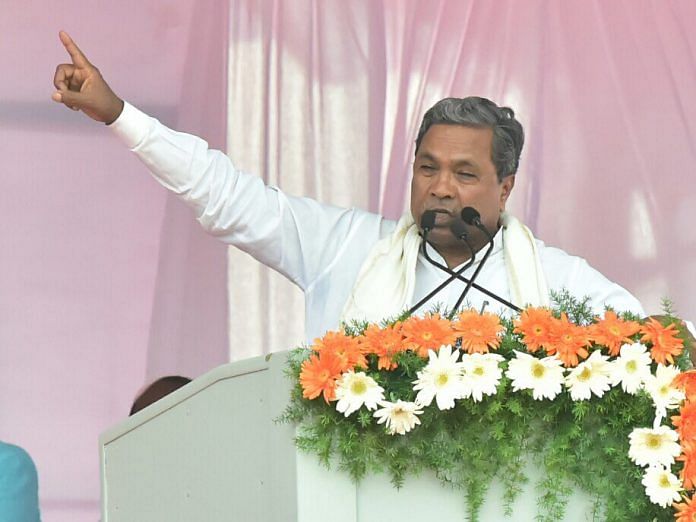For Modi & BJP, stopping Congress from retaining power is even more important than forming the govt, because of the momentum it can provide the grand old party.
Summer arrives early in south India, typically by mid-March. In poll-bound Karnataka though, the temperature has begun to rise in February itself, as national leaders descend on the state, touring various parts.
Narendra Modi himself was in Karnataka Sunday night for a two-day visit, for the second time in a fortnight. The first visit was to Bengaluru, the state capital, where he addressed a parivarthan (transformation) rally. His stinging critique of the Siddaramaiah-led Congress government at that rally drew an aggressive response from the combative chief minister at a press conference the very next day.
Nationally, Siddaramaiah may not be known as a Modi-baiter, but he clearly wants to be a Modi-stopper, at least in Karnataka. So, he changed his mind about retiring from electoral politics, as he had declared in 2013, and decided to lead Congress in this election. Siddaramaiah is the first chief minister since the 1970s to complete a full term and his deft political management of the state has only enhanced his stature.
In his Kannada speeches, Siddaramaiah has consistently adopted a belligerent tone towards Modi. While he has been cordial towards Modi during the latter’s official visits to Karnataka, he seems to avoid engaging Modi in Delhi. He has rarely lobbied to get central schemes to Karnataka or secure clearances or funding for infrastructure projects.
Siddaramaiah also ignored his nomination by Modi as the ‘prabhari’ for the Swachh Bharat Abhiyan. Whether it is a genuine personal dislike or ideological opposition, Siddaramaiah has kept his distance from Modi and now wants to take him on. Not surprisingly, 2018 is turning into a Modi vs Siddaramaiah contest.
For Modi and the BJP, stopping the Congress from retaining power in Karnataka is perhaps even more important than forming the government. A Congress victory at this time is bound to provide substantial momentum to the grand old party in the upcoming state and parliamentary elections.
So, when Modi returned to Karnataka Sunday, his visit was structured around programmes in Mysuru, Siddaramaiah’s hometown. Three weeks earlier, on Republic Day, Amit Shah too held a rally there despite a bandh called by Kannada activists.
Mysuru isn’t just Siddaramaiah’s hometown. This former royal town also provides identity to the region around it, the old Mysuru region. It is here that the BJP is perhaps at its weakest in the entire state, and has never done well outside the Bengaluru Metropolitan area. BJP’s success in the state assembly elections would depend on its performance in the old Mysuru region.
During his visit, Modi launched a slew of development activities, mainly railway and highway projects. In particular, Modi announced the expansion of the Bengaluru-Mysuru national highway, perhaps the busiest road in Karnataka. The Rs 6,800 crore project had, in fact, been approved by the UPA government in 2014 itself. However, the project hadn’t moved an inch.
It was almost as if Modi wanted to mock Siddaramaiah for not acting expeditiously to create a world-class highway to his hometown.
At the Mysuru parivarthan rally, Modi spoke for 45 minutes in Hindi. Since BJP has to ride on Modi’s coattails, just as in Gujarat, to secure victory in Karnataka, the curious political observer had two questions: What is Modi’s critique of Siddaramaiah? And would he effectively communicate the same in Hindi to his Kannada-speaking audience?
Modi characterised Siddaramaiah as divisive, corrupt and petty.
He didn’t openly refer to Siddaramaiah’s AHINDA (Muslim, Backward and Dalit) politics or Congress’s efforts to break the Lingayat community by promoting demands made by some for minority status. Nor did he speak of caste-mobilisation politics, as he explicitly did after the Gujarat election results in December 2017. Yet his target was clear: the caste identity politics as practised by the Congress divides society and should be abandoned.
Modi characterised the Siddaramaiah government as corrupt, wasteful, and therefore, indifferent towards the aspirations of the people. Calling this government the ‘commission government’, which stays in power by sending money to the Congress high command, Modi argued that such a government is a threat to democracy.
Modi also called Siddaramaiah petty and small-minded for not engaging the central government for more resources to develop more infrastructure projects. If one were to approach the Ganga with a small mug, only a little water can be secured, he exclaimed.
Drawing a contrast with his own party and government, Modi claimed that BJP has a different ethic towards governance and will be a ‘mission government’. Perhaps realising his state BJP colleagues may not have a good governance record, Modi took upon himself the onus of supervising the BJP government.
Whether Modi’s arguments will convince the voters of the old Mysuru region will depend on two factors. First, will his political rhetoric expressed in Hindi, which wasn’t translated at the rally, reach the bulk of the voters? It was clear at the Mysuru rally that the audience struggled with the nuances of his argument. Second, does the presence of state BJP leaders, who themselves have faced corruption charges, undermine Modi’s political arguments?
Prithvi Datta Chandra Shobhi is a social historian and political commentator based in Mysuru.



